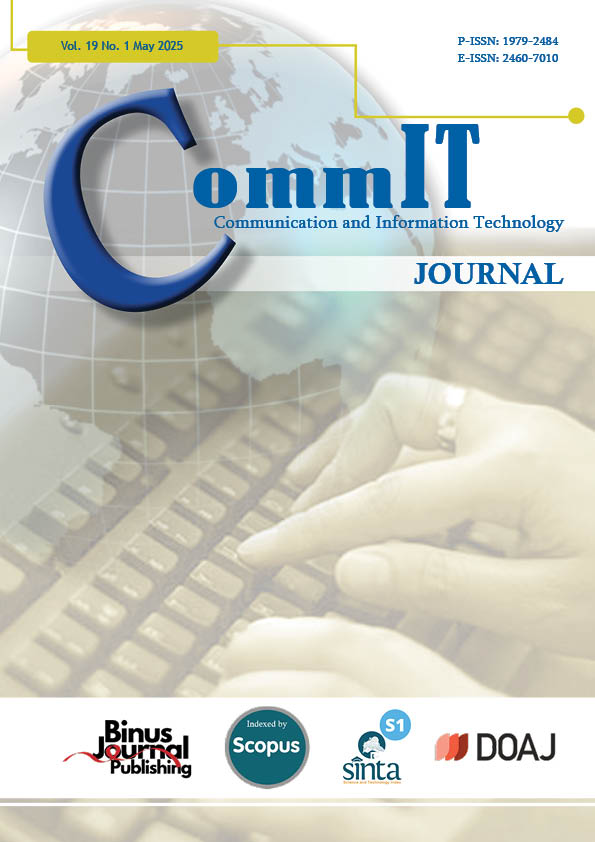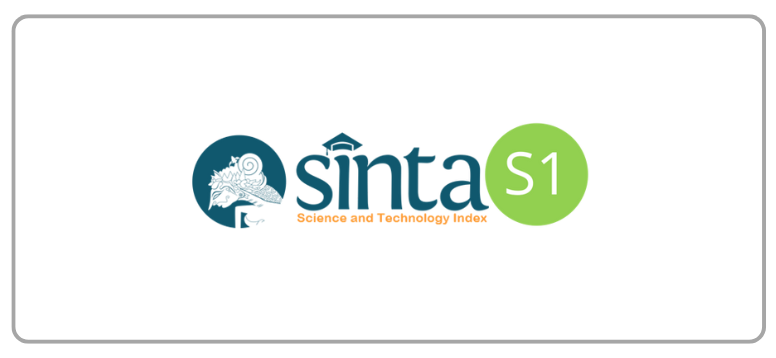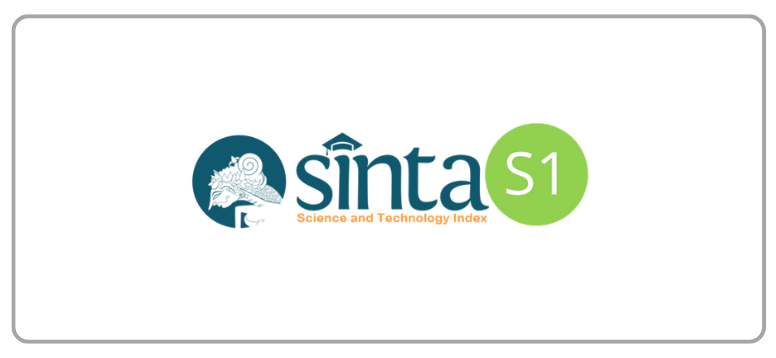Project Management Strategy for Chatbot Implementation Based on ITIL v4: A Logistics Company Case
DOI:
https://doi.org/10.21512/commit.v19i1.12106Keywords:
Project Management Strategy, Chatbot, Information Technology Infrastructure Library version 4 (ITIL v4), Logistics CompanyAbstract
The rapid development of information technology drives improvements in service quality, including help desk services that act as a central point of customer support. The research aims to enhance the achievement of Service Level Agreement (SLA) response and resolution targets in a digital port and logistics company that has yet to meet its SLA response goal of 95%, with an average fulfillment of only 64%. The research adopts a descriptive qualitative method using a case study approach. Data were collected through SLA reports from December 2023 to April 2024 and interviews with the helpdesk team. The research object is the company's helpdesk system. The analysis is conducted using the Information Technology Infrastructure Library version 4 (ITIL v4) framework through Service Value Chain (SVC) practices and supported by an Agile approach. The results show that implementing an ITIL v4-based chatbot combined with Agile practices can significantly improve SLA response due to the chatbot's availability and instant response capabilities. Additionally, SLA resolution is also improved as the chatbot supports initial triage and accelerates ticket routing to the appropriate teams. The average gap after implementation indicates a 26% improvement in SLA response and a -1% gap in SLA resolution (exceeding the target). The research highlights the strong potential of integrating ITIL v4 into chatbot design and management, even though academic studies exploring the relationship between ITIL v4 and chatbot functions remain limited.
References
[1] J. Asbullah and T. Triase, “Rancang dan bangun aplikasi helpdesk support system berbasis website pada CV. Gyar Indonesia,” Jurnal Ilmiah Betrik: Besemah Teknologi Informasi dan Komputer, vol. 14, no. 1, pp. 195–204, 2023.
[2] A. F. J. Nugroho and M. I. Fianty, “Streamlining IT help desk and incident management: Harnessing the power of the ITIL framework for enhanced efficiency in IT services,” Journal of Information Systems and Informatics, vol. 5, no. 2, pp. 683–695, 2023.
[3] N. Khoirunnisa, N. N. Purnawan, and M. P. Siregar, “Standarisasi dokumen kelengkapan ITSM untuk area technical support menggunakan ISO 20000 pada Divisi IT PT Ralali,” Jurnal Teknik Mesin, Elektro dan Ilmu Komputer, vol. 2, no. 2, pp. 73–84, 2022.
[4] Y. Priatama, A. Nugroho, and M. N. N. Sitokdana, “Evaluasi tatakelola teknologi informasi di PD BPR Bank Bapas 69 Magelang menggunakan ITIL v3 domain service strategy,” Jurnal Mnemonic, vol. 2, no. 1, pp. 28–34, 2019.
[5] R. Sutoyo, A. Chowanda, A. Kurniati, and R. Wongso, “Designing an emotionally realistic chatbot framework to enhance its believability with AIML and information states,” Procedia Computer Science, vol. 157, pp. 621–628, 2019.
[6] H. Dihingia, S. Ahmed, D. Borah, S. Gupta, K. Phukan, and M. K. Muchahari, “Chatbot implementation in customer service industry through deep neural networks,” in 2021 International Conference on Computational Performance Evaluation (ComPE). Shillong, India: IEEE, Dec. 1–3, 2021, pp. 193–198.
[7] J. Feliciana and R. I. Desanti, “The recommendation of incident management for helpdesk division PT. X using ITIL v3 framework,” Journal Information System Development (ISD), vol. 8, no. 2, pp. 66–71, 2023.
[8] Y. P. Sari, M. B. Akbar, and T. Sutabri, “Analisis smart school manajemen layanan ujian akhir semester pada aplikasi Qualitiva menggunakan framework ITIL versi 3 di SMA,” Bulletin of Information Technology (BIT), vol. 4, no. 4, pp. 515–523, 2023.
[9] R. Prasasti, A. A. Zulfahmi, N. Wilis, and S. Budi, “Pengelolaan incident management berdasarkan ITIL v4 dan prediksi penyelesaian insiden dalam rangka optimalisasi layanan sebagai upaya meningkatkan kepatuhan wajib pajak,” in Seminar Nasional Pengaplikasian Telematika (SINAPTIKA), 2022, pp. 89–97.
[10] J. Y. Mambu, E. Matindas, S. Adam, and T.Wulyatiningsih, “Self assessment manajemen layanan menggunakan framework Information Technology Infrastructure Library (ITILv4) pada incident management Rumah Sakit Hermina, Lembean, Sulawesi Utara,” Jurnal Informasi dan Teknologi, vol. 5, no. 2, pp. 9–18, 2023.
[11] D. Dzemydien˙e, S. Turskien˙e, and I. ˇ Sileikien˙e, “Development of ICT infrastructure management services for optimization of administration of educational institution activities by using ITIL-v4,” Baltic Journal of Modern Computing., vol. 11, no. 4, pp. 558–579, 2023.
[12] B. A. Sekti and S. N. Kholifah, “Analisis tingkat kematangan aplikasi Tangerang LIVE dalam mengelola incident management, problem management, dan service desk menggunakan framework ITIL v4,” Jurnal Teknologi Informatika dan Komputer, vol. 10, no. 1, pp. 187–202, 2024.
[13] Z. S. Maharrani, L. P. Sumirat, and Y. Kristyawan, “Pengukuran kinerja sistem e-learning UNITOMO menggunakan framework ITIL v4,” Progresif: Jurnal Ilmiah Komputer, vol. 20, no. 1, pp. 529–539, 2024.
[14] F. A. Kojongian and M. Ayub, “Manajemen risiko divisi sistem informasi perguruan tinggi dengan framework COBIT 5,” Jurnal Teknik Informatika Dan Sistem Informasi, vol. 7, no. 1, pp. 274–286, 2021.
[15] P. C. Susanto, D. U. Arini, L. Yuntina, J. P. Soehaditama, and N. Nuraeni, “Konsep penelitian kuantitatif: Populasi, sampel, dan analisis data (Sebuah tinjauan pustaka),” Jurnal Ilmu Multidisplin, vol. 3, no. 1, pp. 1–12, 2024.
[16] I. R. D. Putri and I. K. D. Nuryana, “Analisis manajemen insiden dan masalah pada helpdesk terhadap perbaikan kualitas pelayanan publik berdasarkan framework ITIL v4 (Studi kasus: Dispendukcapil Kota Kediri),” Journal of Emerging Information System and Business Intelligence (JEISBI), vol. 5, no. 1, pp. 173–181, 2024.
[17] J. A. Adelila and H. P. Chernovita, “Analysis of e-court incident management in Salatiga district court using the ITIL v4 framework,” JATISI (Jurnal Teknik Informatika dan Sistem Informasi), vol. 8, no. 2, 2021.
[18] Y. Al-Ashmoery, H. Haider, A. Haider, N. Nasser, and M. Al-Sarem, “Impact of IT service management and ITIL framework on the businesses,” in 2021 International Conference of Modern Trends in Information and Communication Technology Industry (MTICTI). Sana’a, Yemen: IEEE, Dec. 4–6, 2021, pp. 1–5.
[19] D. Berger, N. Shashidhar, and C. Varol, “Using ITIL 4 in security management,” in 2020 8th International Symposium on Digital Forensics and Security (ISDFS). Beirut, Lebanon: IEEE, June 1–2, 2020, pp. 1–6.
[20] P. Y. Reyes-Delgado, M. Mora, F. Wang, and J. M. G´omez, “AHP evaluation of rigorous and agile IT service design-building phasesworkflows in data centers,” The Journal of Supercomputing, vol. 79, no. 16, pp. 18 089–18 166, 2023.
[21] S. P. Safrina, I. Santosa, and W. A. Nurtrisha, “Asesmen dan peningkatan manajemen layanan teknologi informasi pada practice incident management dan problem management menggunakan ITIL 4. Studi kasus: RiYanTI Telkom University,” eProceedings of Engineering, vol. 10, no. 2, pp. 1434–1443, 2023.
[22] I. I. Dwitawati, S. Sururi, N. Ananda, K. Ridha, I. Hakim, R. H. Fatia, and M. Ramadhan, “Eksplorasi ITIL v4 dan COBIT 2019 sebagai framework tata kelola informasi & teknologi pada organisasi,” Journal of Information Technology (JINTECH), vol. 4, no. 2, pp. 69–78, 2023.
[23] M. A. Quintana, R. R. Palacio, G. B. Soto, and S. Gonz´alez-L´opez, “Agile development methodologies and natural language processing: A mapping review,” Computers, vol. 11, no. 12, pp. 1–22, 2022.
Downloads
Published
How to Cite
Issue
Section
License
Copyright (c) 2025 Dendy Setyowibowo, Teguh Raharjo, Anita Nur Fitriani

This work is licensed under a Creative Commons Attribution-ShareAlike 4.0 International License.
Authors who publish with this journal agree to the following terms:
a. Authors retain copyright and grant the journal right of first publication with the work simultaneously licensed under a Creative Commons Attribution License - Share Alike that allows others to share the work with an acknowledgment of the work's authorship and initial publication in this journal.
b. Authors are able to enter into separate, additional contractual arrangements for the non-exclusive distribution of the journal's published version of the work (e.g., post it to an institutional repository or publish it in a book), with an acknowledgment of its initial publication in this journal.
c. Authors are permitted and encouraged to post their work online (e.g., in institutional repositories or on their website) prior to and during the submission process, as it can lead to productive exchanges, as well as earlier and greater citation of published work.
Â
USER RIGHTS
All articles published Open Access will be immediately and permanently free for everyone to read and download. We are continuously working with our author communities to select the best choice of license options, currently being defined for this journal as follows: Creative Commons Attribution-Share Alike (CC BY-SA)




















